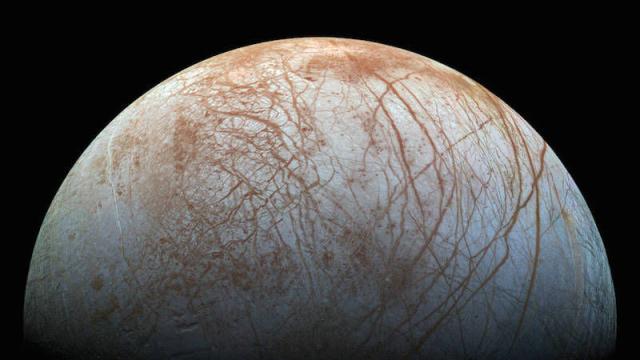Humans hoping to launch themselves to another planet or even into the Sun are sadly out of luck — for now. But in a few billion years, when the Sun becomes a red giant and destroys our terrestrial oceans, future folk will hypothetically be able to make their homes elsewhere. Saturn and Jupiter’s icy moons — Enceladus and Europa, respectively — have topped the list for future Earthling getaways. But new research suggests that these worlds might not be so habitable, even after their icy surfaces melt.
Image: NASA/JPL-Caltech
According to a study published today in Nature Geoscience, researchers used 3D global climate models to simulate how icy worlds around F and G-type stars (like our Sun) might skip a habitable period once they melt. The team found that the simulated worlds required an incredibly high amount of energy to melt the icy surface, and that when the Sun becomes hot enough to do so in a few billion years, they quickly transitioned to a “greenhouse state”, skipping over a habitable phase. The oceans evaporated and left any hope for water-based life out of luck. Since our Sun is a G-type star, this doesn’t bode well for the future of Enceladus and Europa.
This study piggybacks on another one from last May, which found that the habitable zone within our solar system will expand as our Sun does.
“There’s a couple caveats,” Ramses Ramirez, a research associate in the Carl Sagan Institute at Cornell University and co-author on both studies, told Gizmodo. “This really only applies to F and G stars, so stars like [our] Sun or a little brighter than our Sun.”
So, at least there’s some hope for future humans who might be able to escape to icy exomoons. Icy worlds around K and M-type stars — which are cooler and less luminous than our Sun — might enjoy a period of habitability once their surface melts.
“If you had Europa and Enceladus analogues around those stars, they’d probably be safe,” Ramirez noted.
There’s also the fact that this is a model, and as our own solar system’s history shows, the transition between icehouse and greenhouse states can be complicated. “Geological evidence shows that early Earth had both warm episodes and snowball episodes. And early Mars once had liquid water flowing on its surface, even though Mars today is dry and frozen,” Andrew P. Ingersoll at the Division of Geological and Planetary Sciences at CalTech wrote in an accompanying Nature News & Views article. “The lesson for the search for habitable worlds beyond our Solar System is that our models, based on Earth experience, still have large uncertainties.”
Obviously, much more research around icy moons has to be conducted before we rule them out as future places of refuge once Earth-like biospheres are toast. But it’s a good reminder that even if you’re having a bad day on Earth, things could always be worse — you could be trapped on an icy moon with a rapidly vaporising ocean.
